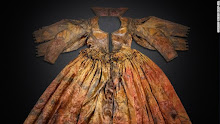My article, "Designing Glow," features some of our favorite television dramas with brides and their wedding gowns designed to glow! Just published in the fall issue of SEASON magazine (page 54 online), I share it below with images added from Downton Abbey, Game of Thrones and Outlander. Enjoy!
Designing Glow
As a fashion historian, I enjoy reading about the creative
process used by costume designers for period films and television dramas. And
as a wedding folklorist, writing about the bride’s rite-of-passage, I’ve come
to see how a woman’s deep desire to be beautiful on her wedding day reflects a
universal expression of the feminine spirit, tapping into her true goddess
nature, her radiance.
In the last few years, brides have found fashion
inspiration from the work of those costume designers in touch with such an
aspiration—a woman’s wish to glow! Remember
the first family wedding on Downton Abbey?
Set in 1920, costume designer Caroline McCall had more than designing something
with a romantic vintage vibe in mind. For Lady Mary’s marriage to Matthew
Crawley, she etched the slender gown’s lace overlay with a delicate silver
thread, adding tiny Swarovski crystals and rice pearls so Mary would “twinkle
in the morning light.”
Then there’s the shimmery sensuality of Game of Thrones! In the exotic
imagination of Michele Clapton, its award-winning costume designer, the ornately
intricate Westeros wedding gowns—with their golden palettes; metallic embroidered
dragons, lion heads and Diawolfs; primitive lacework and flowing trains—turned the
show’s brides into gleaming, other-worldly creatures.
Modern brides adapted this
Medieval-like fantasy with crystal diadems and mystical glamour, ancient armor-inspired
motifs (seeking their inner Wonder Woman?), even replicating Margaery’s elaborate
“hair sausages” and her queenly wedding crown crafted from Baratheon antlers
wrapped in thorny briar roses. (Everything candlelit for epic “glow effect”!)
For the long-awaited reenacting of Outlander’s 18th century wedding set in the Scottish Highlands, the
costume designer wanted Claire—the bride and time-traveling heroine—to
literally glow. “I wanted a dress
that would be incredible in candlelight,” Terry Dresbach shared. This
wedding—and forthcoming marriage and relationship of Claire Beauchamp Randall and Jamie Fraser—were
the foundation of the immensely popular Outlander
books and subsequent television series, therefore the direction from the show’s
creator: “This moment needed to be a fairy tale.”
“In the 18th century, metallic textiles were made with actual
metal woven into the fabrics,” explained Terry. “When you put them in a room
filled with candles, they just glow. They’re quite remarkable.” By
incorporating delicate shavings of iridescent mica rock—plus an old,
time-consuming embroidery technique using metal strands—Terry could be true to
the spirit of the era while also creating something stunning and shimmering for
Claire’s wedding gown.
With all this focus on “glowing,” I thought of Regena Thomashauer,
best-selling author and founder of the School of Womanly Arts in New York City.
The heart of Regena’s work encourages women to find and express their true
desires, their self-love, their inner and outer goddess, their glow. “Glow creates beauty in women of
all ages, all body types, all backgrounds,” Regena observes. And when you glow,
you not only want to dress to show it off, but you just naturally attract and
inspire what’s beautiful in others. ~
























